
Terrariums offer a stylish, space-saving, and portable way to display some of our favorite plants. Terrariums can be big or small. They can feature a collection of plants or just a single interesting specimen. They can be tropical or even arid. But the best part is that they can be fun and creative – allowing your own personality and style to shine through – with the help of some unique glassware, some colorful rock, and some amazing plants. Here, we’ll talk about the options in product and plants you have to work with and provide a few tips for making your terrarium project successful.

Containers, Rock, and Soil
If you look at all the interesting glassware in our Terrarium Shop, you’ll see the wide variety of sizes, shapes, and styles available for creating a terrarium. Some are completely open in the top – glass versions of a classic plant container. In contrast, some terrarium glassware is completely closed with a lid. And in others, the design is partially enclosed, incorporating some kind of an opening that allows a limited amount of air to flow. Each of the different styles – open, closed, and semi-open – will create different environments for your plants. The more enclosed the container, the more moisture is contained inside, and the more humidity your plants will experience. Ferns, pilea, and mosses are just a few that enjoy lots of humidity and do well in a closed terrarium. Cacti and succulents, however, prefer a more arid environment and do best in a container that’s open. In a semi-enclosed container, many different kinds of plants thrive, including ferns, palms, spider plants, and more.
In addition to the variety of sizes and shapes, you’ll probably notice something else about these glass containers too – none of them have drain holes. For plant parents, a terrarium’s lack of drainage may seem counter-intuitive to proper plant care, but don’t let that stop you from trying your hand at creating a terrarium display. There are products and methods – layers of rock, sand, charcoal – that not only help us get around the drainage issue, but because we can see through the glass, the layers become part of the artistic expression of terrarium-building. As with any type of container, it’s important to keep the plants’ roots from sitting in water, so the first layer in a terrarium should be rock or gravel. Extra water can settle into this layer, separated from the soil. Next is a layer of charcoal which – especially in semi-enclosed or closed terrariums – will keep the environment fresh by filtering the water and removing odors. On top of that, you’ll need a water-permeable barrier – like burlap, landscape cloth, or perhaps panty hose – to keep the next layer, the soil, from sifting down into the charcoal and rock. The type of soil you’ll use depends on the needs of the plants you’re growing – regular potting soil for most houseplants or a specialized mix for cacti and succulents. The size and shape of your glass container – as well as the plants – will help determine how shallow or deep each of these layers should be. And although the layers serve a practical purpose, there are opportunities for creativity there too. Rock can be fine-grained like sand and gravel or larger like pebbles. It can be black, white, or marbled in color. In a tall glass container, you can alternate different colors too. In containers with narrow openings, getting these layers in there the way you want may involve long funnels, narrow tongs, and spoons taped to chopsticks, but figuring out these engineering challenges is also part of the fun.
Plants
Classic terrariums are most often tropical-themed arrangements featuring moisture-loving plants – but in miniature. In our Terrarium Shop, you’ll find a wide selection of irresistibly baby-sized versions of some of your houseplant favorites, including ferns, ivies, peperomia, pilea, spider plants, and more. Our selection of cacti and succulents come in little two-inch pot sizes too. Just be sure that all the plants living together in one terrarium agree on the amount of water they like. Cacti and succulents would be happiest in a completely open container – they and their soil like to breathe. Tropical foliage plants will enjoy the more humid environment found in closed and semi-open styles of glassware. Whichever style you choose, finding the right balance between watering and not watering will take some time as you get to know your terrarium. The general goal is to provide enough water so that you thoroughly wet the soil around the plants’ roots but at the same time avoid allowing excess water to collect in the bottom of the container. It’s an art, and perfecting it is a rewarding achievement. There are times however, when particular plants – especially those dry-loving cacti – won’t make it, and that’s ok. No shame in that. Terrariums are an intriguing balancing act, and updating the design from time to time with new plants can be interesting too.
Or you can skip the rock and soil layering process and simply keep a tillandsia by itself in a small glass globe – also a terrarium of sorts, very cool and minimalistic. Again, you have all kinds of options with terrariums.
Finishing Touches
After the base layers and plants are installed, you can give your terrarium even more character and creative flair with decorative rock, moss, colorful stones, figures, or other trinkets too. You can show off sea shells from your last trip to the beach. Display a group of smooth colorful pebbles. Place benches, stepping stones, gates, and other miniature décor to make it appear that your terrarium is home to a tiny fairy or gnome. A terrarium can be a place to express the personality and creativity that’s uniquely you.
Designing, building, and caring for a terrarium garden will challenge your creativity, your plant care skills, and your engineering prowess all at the same time, making it one of the most engaging and rewarding ways to engage with your plants. So, take a walk through our Terrarium Shop – it’s full of inspiration for creating your own little garden under glass. And if you need advice, just ask. Our expert team will be glad to help.


